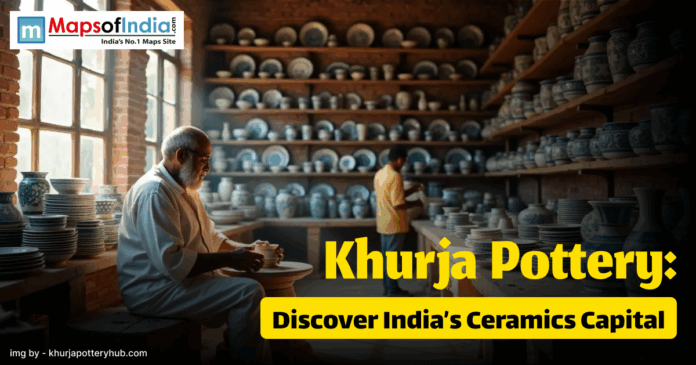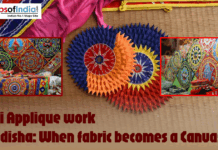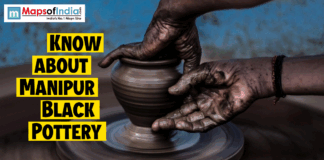In India, there are various jobs where craftsmanship is famous across the various states. People practice different kinds of things that change according to the region you travel in India. The pottery system of Khurja Pottery is known as one of the biggest and famous craftsmanship styles that is practiced in India. This style is famous for its vibrant designs and smooth glazed finish that is applied to the craft. Now, becoming a world-famous craftsman started from the town of Khurja, which is in Uttar Pradesh. The town in UP is most of the time known across the world as the “Ceramics Capital of India”. This time with time is becoming a long association with pottery production and its significant role in the Indian ceramics industry. The developing craftsman style of Khurja is working as a bridge to fill the gap between heritage and modern design.
The Historical Roots of Khurja Pottery
When you go and try to find the beginning of this great artistic form, it will show you that it started around 600 years ago. It is believed that this art form of pottery making started around the Mughal era. It gained traction when skilled potters migrated from the Mughal-ruled Delhi to the other regions near Khurja. With the migration from the main city, they brought so many things with them, and with that, they also brought artisans who brought Persian and Central Asian glazing techniques of pottery, and these techniques have transformed the local pottery tradition, changing it into the now-famous Khurja pottery. As time went on, with the rise of foreign inventions and influence from various cultures, it developed into a unique style.
The Art and Process of Making Khurja Pottery
The pottery style of Khurja is famous across the world and is known for the distinctive look this work has, the smooth surface of the pot, and the glossy finish. This is loved by everyone. The high-quality clay is collected from nearby regions of Khurja. The obtained clay here is refined and then properly kneaded, and after that, it is given the desired shape on a potter’s wheel. It can come in various forms like plates, bowls, cups, tiles, and decorative pieces. After getting the desired shape, the created piece will be dried properly with so much care that it will mostly remove moisture before they are fired in kilns at high temperatures. The pot makers, after that, apply a glaze which is made from a mix of things like silica and metal oxides. This helps to give this pottery the well-known and famous shine.
The Signature Designs and Motifs
The main beauty of this Khurja Pottery resides within the hand-painted patterns on the pots and the colour palette that is used here. The traditional designs on this pottery work most of the time have the designs that show floral motifs, various well-liked geometric patterns, and repetitive symmetrical elements. The most well-known colour combination of this art form is Blue and white, and this combination is really a lot recognizable, with the use of modern artisans who are now experimenting with greens, yellows, and reds. The designs on these pots are taking big inspiration from nature, a bit from Mughal architecture, and a bit from folk art. As time progressed, these motifs have become a culturally known part of Khurja identity, showing both heritage and innovation.
Khurja as a Contemporary Ceramic Centre
With the progress that has been made over the years the Khurja is not only a traditional pottery but a prospering industrial town with a speciality in ceramics. The area accommodates scores of small- and medium-sized units making a variety of ceramic products such as tiles, sanitary ware, and tableware. Government programs such as the Khurja Ceramic Cluster Development Program and training programs have funded modernization without compromising on the art’s essence. There are better kilns, more advanced glazing technology and quality control mechanisms now in Khurja to compete in the domestic as well as in the export market. It is also a key supplier for big retail chains and the hospitality sector.
Economic Significance and Employment
Khurja Pottery is an important activity in the economy of the Bulandshahr district. There are thousands of pottery labourers and traders who are employed in this work. The business employs men and women at various levels of production, ranging from the preparation of clay and moulding to painting and glazing. The craft has further encouraged allied industries such as packaging, transport and retail. Khurja products find their way to markets in India and are shipped to European, Middle Eastern and Asian nations.
Cultural Heritage and Identity
Even though we look at this with the monetary angle, the art of Khurja poetry is much more than a thing to generate revenue for the people living there. This has become the cultural pride for people living here. This unshakable feat is achieved by the skilful work and artistic prowess that are followed by generations of potters who created the beautiful pieces from the clay. Many families that are living in North India still hold Khurja pottery work as a proud profession.
Sustainability and Environmental Elements
In recent years, there has been an increase in the emphasis on sustainable production within Khurja. Quite a number of workshops have started adopting energy-efficient kilns and green glazes. There are attempts made towards minimizing water usage and emissions from the firing activity. Some artisans have also transitioned to solar-powered machinery and green packaging. These are measures that align with the international direction towards sustainable crafts.
Problems Encountered by Craftsmen
Notwithstanding its image, Khurja Pottery encounters a number of problems. Increased prices of raw materials, competition from industrially produced ceramics, and poor access to finance have an impact on small craftsmen. The next generation is usually inclined towards other occupations because of unpredictable earnings from pottery. There is also no uniform branding and web presence, which restricts market growth. Fluctuations in seasonal demand and limited information regarding trends in design also contribute to the problem. Still, most NGOs and start-ups are currently supporting artisans with e-commerce training, designing, innovation, and digital marketing in order to overcome these hurdles.
Conclusion
Khurja Pottery is a classic combination of art, culture, and workmanship. This unique and different art that started in the small town of UP has now spread across the world, making it a global icon. The artisans who are creating the art from these clays are really proud of the work they do here. Their work is making a cultural shift and changing the pottery into a narrative of tradition.





